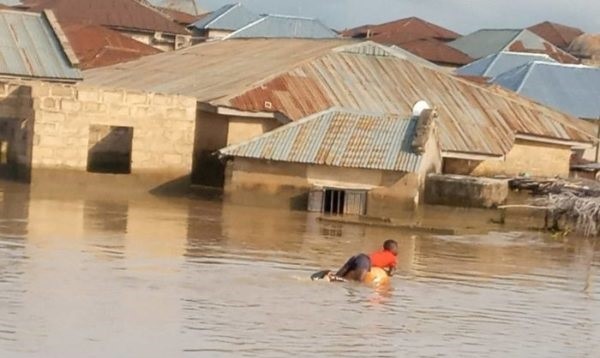In recent years, increased flooding has resulted in the spread of diseases, loss of lives and property, with low-lying and coastal areas being the most affected.

The Nigeria Hydrological Services Agency (NIHSA), in its effort to address the challenge of flooding across the country, has been intervening since 2013 by publishing Annual Flood Outlook (AFO), following the devastating effects of the 2012 flooding in the country.
The 2012 floods began in early July, killed 363 people and displaced over 2.1 million people as at Nov.5.
According to the National Emergency Management Agency (NEMA), 30 of Nigeria’s 36 states were affected by the floods.
The floods were described as the worst in 40 years and affected about seven million people.
The estimated damages and losses caused by the floods were worth N2.6 trillion
The menace of flooding is caused mainly by rapid population growth, lack of policy for flood control, poor drainage facilities and decaying infrastructure, lack of proper environmental planning and management strategies.
Other causes are indiscriminate dumping of refuse, climate change phenomenon, coupled with inadequate preparation and other human activities.
Mr Clemet Nze, the Director General of NIHSA, said that the AFO reports and effective sensitisation campaigns by the agency had saved the country from huge revenue losses that would have resulted from flooding.
He said that the AFO was a means of producing early flood warning information for stakeholders to use and mitigate flood related disasters.
“Flood forecasting and flood early warning is the agency`s mandate.’’
He said that the AFO report showed that 36 states, including the Federal Capital Territory (FCT) witnessed different levels of flooding in 2019.
He added that out of the 774 local government areas in the country, 74 were predicted to be highly probable.
“While 279 local government areas were probable areas of flood, 421 were predicted to be less probable.’’
Nze said that the steady rise in river level caused flooding in Adamawa, Taraba and Benue states.
“States affected by various degrees of flooding in 2019 were Katsina, Sokoto, Zamfara, Kaduna, Kwara, Adamawa, Benue, Bauchi, Gombe, Plateau, Taraba, Yobe, Kogi and Nasarawa.
“Others are Anambra, Delta, Bayelsa, Rivers, Edo, Lagos, Ogun, Osun, Oyo, Abia, Cross River, Borno, Jigawa, Kano, Ekiti, Oyo and FCT.
“More than 100 local government areas within the states listed below are counting their losses.’’
Nze said that relevant stakeholders, especially individuals and state governments failed to heed the warning issued before the onset of flooding season across the country in 2019.
He said that the agency was concerned about the non-adherence by Nigerians to flood predictions for 2019.
“Thereby, resulting in avoidable flooding incidents, leading to loss of lives, property, disruption of economic activities and loss of several hectares of agricultural lands.’’
He said that the Nigerian Meteorological Agency (NiMet), also predicted late onset of rainy season in the country in 2019 and early cessation.
“Meaning that rainfall started very late and ended early in some states and by Sept. 26 2019, rainfall ceased in Katsina, Sokoto and moved down to the south.
“But in the southern parts of Nigeria, rainfall continued till November and even December in places like Bayelsa, Rivers, even Delta experienced rainfall up to late November.’’
He said that the agency had been monitoring the flooding taking place across the country with the attendant loss of lives and property.
Nze said that River Benue increased steadily due to local rainfall with attendant heavy inflows from the tributaries of the river.
According to him, river flooding as well as coastal flooding have come to stay, as floods from the upper catchment of the Niger basin is mandatory.
He warned government at all levels, stakeholders as well as general public to adhere to warning issued by the agency before the onset of flooding season in 2020.
He said that adherence would help to prevent flooding across the country.
Mr Moses Umekwe, an environment expert, said that blockage of drains, rainstorms and poor urban planning, resulting in erection of structures within floodplains and waterways were the causes of more flooding in coastal areas.
Umekwe urged Nigerians to endeavour to remove structures built within the floodplains, clear blocked drains, culverts and other waterways to avoid unnecessary flooding in 2020.
He also advised Nigerians to cultivate the habit of planting trees to protect the environment and check flooding.
Mr Williams Osaze, the President, Society for the Promotion of Peoples Right, an NGO, also urged the Federal Government and other relevant stakeholders to collaborate for effective sensitisation on ways to prevent flooding in the country.
Osaze also an environmentalist said that the collaboration would increase and improve effective sensitisation, especially in various flood prone communities.
He also advised the Federal Government to enforce building codes and provide effective flood forecasting warning systems to mitigate flood risk across the country.
He said that building codes would contribute significantly to mitigating flooding, “if Nigerians can as well obey the codes.
“It is not only to provide building codes or building plan, but it is also important to obey the codes.’’
Osaze appealed to Nigerians to avoid actions that could impede free and easy flow of water through its natural courses to avert devastating flood disasters.
By Vivian Emoni, News Agency of Nigeria (NAN)
